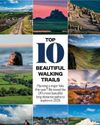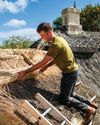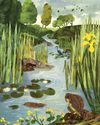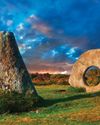The power of awe

The modern Stonehenge 'visitor journey' is surely a far cry from how pilgrims would have experienced the site 4,500 years ago, in its Late Neolithic heyday.
Back then, according to the latest archaeological theories, people would have approached the stones from the woodhenges of Durrington to the east, via the River Avon and a processional pathway that led uphill from the riverbank to the circle itself.
Overlayered by farms, fields and the roaring A303 highway, the chalk 'avenue' is impossible to follow in its entirety on foot today, but you can walk its culminating section over National Trust land from the King Barrow Ridge and down into the dry combe below.
Screened by the slope above, the sarsen trilithons - two large vertical stones supporting a third stone across the top - are not visible at this point. But as you ascend the final section, along the solstitial axis bisecting Stonehenge, they are revealed to dramatic effect.
I'm not a religious person by nature, but the first time I experienced this unveiling, with the stones silhouetted above me against a backdrop of gold-edged cumulus, was a moment I shall remember forever. I fell to my knees, overcome with a feeling that I can only describe as 'awe' - at the scale and power of our ancestors' otherworldly creation, and the glorious setting beneath a sky suffused with sunset colours.
That, of course, was precisely the effect intended by the site's Neolithic architects. Not yet having mastered the mysteries of Gothic vaulted ceilings, as the Normans would do 4,000 years later at nearby Salisbury Cathedral, they exploited the properties of the surrounding landscape to intensify the experience of arriving at the stone circle.
But why? The answer is hinted at in the dictionary definition of awe as "a feeling of reverential respect, mixed with fear or wonder produced by that which is sublime, or extremely powerful".
Bu hikaye BBC Countryfile Magazine dergisinin August 2024 sayısından alınmıştır.
Start your 7-day Magzter GOLD free trial to access thousands of curated premium stories, and 9,000+ magazines and newspapers.
Already a subscriber ? Giriş Yap
Bu hikaye BBC Countryfile Magazine dergisinin August 2024 sayısından alınmıştır.
Start your 7-day Magzter GOLD free trial to access thousands of curated premium stories, and 9,000+ magazines and newspapers.
Already a subscriber? Giriş Yap

TOP 10 BEAUTIFUL WALKING TRAILS
Planning a major hike this year? We reveal the UK's most beautiful long-distance paths to explore in 2025

Free to feel good
We know time outdoors makes you feel better, but if you have a disability, getting out there isn't always easy. That's why charities like the Calvert Trust aim to give everyone the freedom of the countryside.

Vanishing fog
As new findings suggest fog may be disappearing from our world, Fergus Collins meets fog chaser Laura Pashby who treasures its power to transform landscapes - and ourselves

Smithfield's closure will be the end of an era, but it still has a future
What connects the great Victorian novelist Charles Dickens, the comedy actor TerryThomas and a branch of the Henson family?

Electric dreams
Could this new cycling route in the Shropshire Hills become a star of Britain's bikepacking scene? Matt Baird mounts an electric bike to navigate the hills, thrills and basilicas of the Marcher Castles Way

Up on the roof
Thatched roofs have been a part of the British countryside for 5,000 years. Tom Allan is one of a dwindling number of craftspeople making sure this ancient tradition remains a vital part of our rural life.

Sniffer dogs and tiny loos - the fight to save water voles gets serious
What do you do to discover how a much-loved but fast declining and elusive mammal is faring in its battle for survival along our rivers, streams and ditches? First, recruit hundreds of volunteers for look-out duties. Then call in specially trained detector dogs and build tiny floating loos.

RSPB WARNS AGAINST USING FLAT BIRD FEEDERS
The RSPB is reviewing its bird-feeder products over growing concerns about the spread of disease among garden birds

ANCIENT CORNWALL
England's wild far-western shores are scattered with mysterious ancient sites. Melanie O'Shea walks you back through time to the Celtic roots of Cornwall's ruggedly beautiful West Penwith peninsula

Famous terrier breeds
Despite their naturally combative nature, terriers make great pets, with most breeds described as affectionate, friendly, loyal or playful - or a mix of them all. James Fair details six key breeds
